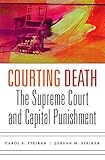Courting death : the Supreme Court and capital punishment / Carol S. Steiker and Jordan M. Steiker.
Material type: TextPublication details: Cambridge, Massachusetts : The Belknap Press of Harvard University Press, (c)2016.Description: 1 online resource (390 pages)Content type:
TextPublication details: Cambridge, Massachusetts : The Belknap Press of Harvard University Press, (c)2016.Description: 1 online resource (390 pages)Content type: - text
- computer
- online resource
- 9780674974852
- KF9227 .C687 2016
- COPYRIGHT NOT covered - Click this link to request copyright permission: https://lib.ciu.edu/copyright-request-form
| Item type | Current library | Collection | Call number | URL | Status | Date due | Barcode | |
|---|---|---|---|---|---|---|---|---|
 Online Book (LOGIN USING YOUR MY CIU LOGIN AND PASSWORD)
Online Book (LOGIN USING YOUR MY CIU LOGIN AND PASSWORD)
|
G. Allen Fleece Library ONLINE | Non-fiction | KF9227.2 (Browse shelf(Opens below)) | Link to resource | Available | ocn961185147 |
Includes bibliographies and index.
Introduction : regulating the death penalty to death -- Before constitutional regulation -- The Supreme Court steps in -- The invisibility of race in the constitutional revolution -- Between the Supreme Court and the states -- The failures of regulation -- An unsustainable system? -- Recurring patterns in constitutional regulation -- The future of the American death penalty -- Life after death.
"Unique among Western democracies in refusing to eradicate the death penalty, the United States has attempted instead to reform and rationalize state death penalty practices through federal constitutional law. Courting Death traces the unusual and distinctive history of top-down judicial regulation of capital punishment under the Constitution and its unanticipated consequences for our time. In the 1960s and 1970s, in the face of widespread abolition of the death penalty around the world, provisions for capital punishment that had long fallen under the purview of the states were challenged in federal courts. The U.S. Supreme Court intervened in two landmark decisions, first by constitutionally invalidating the death penalty in Furman v. Georgia (1972) on the grounds that it was capricious and discriminatory, followed four years later by its restoration in Gregg v. Georgia (1976). Since then, by neither retaining capital punishment in unfettered form nor abolishing it outright, the Supreme Court has created a complex regulatory apparatus that has brought executions in many states to a halt, while also failing to address the problems that led the Court to intervene in the first place. While execution chambers remain active in several states, constitutional regulation has contributed to the death penalty's new fragility. In the next decade or two, Carol Steiker and Jordan Steiker argue, the fate of the American death penalty is likely to be sealed by this failed judicial experiment. Courting Death illuminates both the promise and pitfalls of constitutional regulation of contentious social issues"--
COPYRIGHT NOT covered - Click this link to request copyright permission:
There are no comments on this title.
